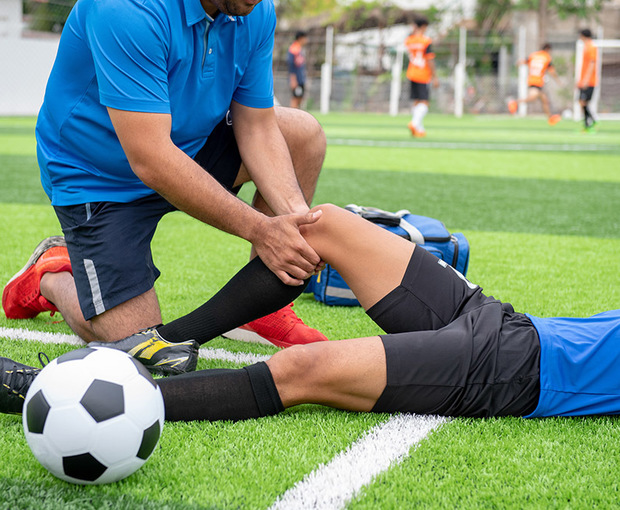Sports injuries are a common occurrence among athletes of all ages and skill levels. These injuries can range from minor strains and sprains to more serious conditions such as fractures and tears. As an athlete, it’s important to be aware of the most common sports injuries and how they can be treated. In this article, we will discuss some of the most common sports injuries and how sports physiotherapy can help.
Table of Contents
1. Sprains and Strains
Sprains and strains are the most common types of sports injuries. Sprains occur when a ligament is stretched or torn, while strains involve the stretching or tearing of a muscle or tendon. Both of these injuries are painful and can lead to swelling, stiffness and a decrease in range of motion. Treatment typically involves rest, ice, compression and elevation (RICE). Sports physiotherapy in Edmonton can be used to help strengthen the affected area, improve range of motion and reduce pain.
2. Concussions
Concussions are a type of traumatic brain injury that can occur in contact sports such as football, hockey, and soccer. Symptoms of a concussion include headache, dizziness, confusion, and memory loss. It’s important to seek medical attention immediately if a concussion is suspected.
Concussions are a serious concern for athletes participating in contact sports. They occur when the brain is jolted or shaken inside the skull, usually from a blow to the head. Symptoms of a concussion can be difficult to identify, but may include headache, dizziness, confusion, and memory loss and it’s important for anyone suspected of having a concussion to seek medical attention immediately, as untreated concussions can lead to long-term brain damage and other complications. Athletes and coaches should also take steps to prevent concussions by using proper safety equipment and following proper technique when playing sports.
3. Tennis Elbow
Tennis elbow is a condition that causes pain and tenderness in the outer part of the elbow. It’s often seen in athletes who play racquet sports such as tennis or squash, but it can also occur in athletes who perform repetitive arm movements such as weightlifting or throwing.
The pain associated with tennis elbow is caused by overuse of the tendons in the forearm that attach to the outer part of the elbow. This overuse results in small tears in the tendon, leading to inflammation and pain. Symptoms of tennis elbow include pain and tenderness on the outer part of the elbow, weakened grip strength, and difficulty holding objects. Treatment for tennis elbow typically involves rest, ice, and physical therapy exercises to strengthen the affected area. In some cases, medication or surgery may be necessary to alleviate the pain and promote healing.
4. ACL Tears
The anterior cruciate ligament (ACL) is a band of tissue that connects the thigh bone to the shin bone. ACL tears are a common injury in sports that involve sudden stops, twists, and turns, such as basketball and soccer. Symptoms of an ACL tear include pain, swelling, and instability in the knee.
The ACL, or anterior cruciate ligament, is a vital band of tissue that attaches the thigh bone to the shin bone. It helps to stabilize the knee joint and prevent it from moving in unnatural ways. Unfortunately, ACL tears are a common injury in many sports, especially those that require sudden stops, twists, and turns, like basketball and soccer. When an ACL tear occurs, it can cause significant pain, swelling, and instability in the knee. Proper treatment and rehabilitation are essential to recover from an ACL tear and prevent further damage to the knee joint.
5. Shin Splints
Shin splints are a common overuse injury that causes pain in the lower leg. They are often seen in athletes who engage in high-impact activities such as running and jumping. Symptoms of shin splints include pain and tenderness along the front of the shin bone.
The pain may also worsen during physical activity and gradually disappear with rest. Shin splints are typically caused by overloading the muscles, tendons, and bones in the lower leg, leading to inflammation and microtears in the tissues. Proper warm-up, stretching, and gradual increase in activity level can help prevent shin splints. Treatment options include rest, ice, compression, and elevation, as well as physical therapy and anti-inflammatory medication in severe cases. It is important to seek medical attention if the pain persists or worsens despite home treatment.
Conclusion
Sports injuries are a common occurrence among athletes of all ages and skill levels. While some injuries can be minor and easily treated, others can be more serious and require more intensive treatment and rehabilitation. Sports physiotherapy can play an important role in the treatment of sports injuries, helping athletes to reduce pain and swelling, improve range of motion, and return to their sport as quickly and safely as possible. If you have been injured while playing sports, it’s important to seek medical attention immediately and to work with a qualified sports physiotherapist to develop a personalized treatment plan.

